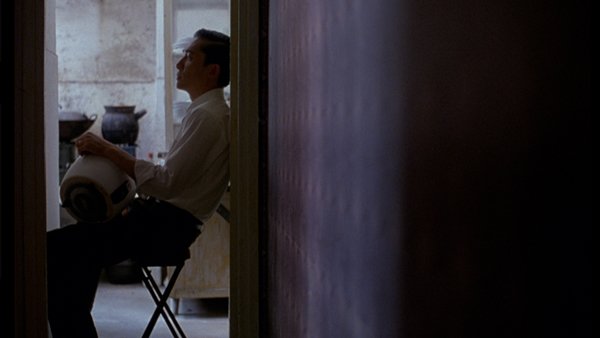How Wong Kar-wai’s Editing in In the Mood for Love Enhances Its Emotional Depth
Wong Kar-wai’s classic film, In the Mood for Love, depicts the love story between neighbors whose spouses have been cheating on them. It illustrates the theme of passion with restraint amidst the backdrop of 1960s Hong Kong. Along with the film’s brilliant performances, lighting, scoring, and script, the film’s use of editing enhances the forlorn tale of love we see on the screen.
Edited by William Chang Suk-ping, a long time collaborator of Wong Kar-wai, the film employs rhythmic editing throughout to enhance the emotional state of the titular characters, Mrs. Chan and Mr. Chow. This deliberate use of editing not only reflects their evolving emotions but also underscores the gradual development of their relationship.
WATCH OFFICIAL TRAILER I 20TH ANNIVERSARY RESTORATION
In the Mood for Love is a slow-paced film. The first half incorporates multiple long shots of Maggie Cheung and Tony Leung just walking, either up the stairs or down the street. For example, in the scene where we see Mrs. Chan buying noodles [14:47–16:07], there are only seven shots, roughly averaging a cut every ten seconds. Most of this scene comprises shots of longer duration. This choice of rhythmic editing complements Maggie Cheung’s pace as she delicately climbs up and down the staircase. It forces the audience to notice her every move, and we see how poised and unwavering she is throughout. This illustrates how careful Mrs. Chan’s every movement is—how she is aware that she is always being watched by the people around her. She is not one to let her guard down. Maggie Cheung’s character plays the role of the perfect woman who does what is expected of her as a well-respected woman of Hong Kong. Through the long takes and a minimized number of cuts, even the action of her dabbing the sweat carefully off her forehead [15:19] is given attention. The audience notices how carefully she proceeds with this action, and we see how Maggie Cheung does this with very subtle expressional changes. This once again feeds into Mrs. Chan’s desire to fit in as the perfect Hong Kong beauty.
As the movie proceeds, Mrs. Chan finds herself attracted to Mr. Chow. As they spend more time together reenacting the affair of their spouses, the line between reality and make-believe becomes blurry. There comes a point where Mrs. Chan can no longer hold back the feelings she has for Mr. Chow. Mrs. Chan receives a call from Mr. Chow and races toward him. In this pivotal scene, Wong Kar-wai changes his style of editing. In this scene, she is walking up and down the staircase again, but there is a difference from the previously mentioned scene. Here, she is not holding back. She runs frantically, paces up and down, pauses, then continues. During this scene, we see Maggie Cheung’s character in a very raw state. We see her as a lover donning red rather than the woman tightly restrained by her cheongsam and society. The editing in this scene brings the change into focus. There are roughly five shots in the first half of this scene [54:06–54:11], averaging around a cut per second. There is then a long shot of Mrs. Chan catching her breath. This is followed by another episode of frantic movements [54:19–54:26], averaging around a cut every 0.77 seconds. This is very fast compared to the film’s overall average. Since the shots are in rapid succession, the audience is not given much time to digest this moment that Mrs. Chan experiences. It shows how fleeting the one time she almost gave in to her love was, and we return once again to the reserved Mrs. Chan.
The use of rhythmic editing is not limited to singular character development but also aids the tempo between Mrs. Chan and Mr. Chow’s interactions. Interactions between Maggie Cheung and Tony Leung’s characters are enveloped in an air of mystery. The actors perform in a way that suits their characters’ desire to not truly show what they are feeling at any given moment. It is the subtle glances and movements that really deliver their feelings. For example, the stirring of a teacup or the smoking of a cigarette both indicate worry or stress, all while they maintain stone-cold stares. Wong Kar-wai has carefully chosen the way the individual shots are aligned during the scene where Mrs. Chan and Mr. Chow first discuss the affair of their spouses [27:50–30:00]. As the conversation steadily progresses, the number of cuts increases. As the final questions, to clarify any lingering doubts they had, are asked, Wong Kar-wai uses the whip pan. This choice of editing punctuates the tempo of their conversation and heightens the tension of the topic of discussion. After this whip pan, there is a long take of Tony Leung as he and the audience are allowed to digest the news received. This mixture of shorter shots, whip pans, and long shots heightens and then diffuses the tension. It complements the emotional state of both characters. At first, they are hesitant to openly discuss the affair, but as they proceed, the pace changes. Wong Kar-wai dwells on longer shots when they act, allowing the audience to take the time to study the two characters. But as the whip pans begin, we aren’t given the time to really see what they feel.
Similarly, in one of the final interactions between Mrs. Chan and Mr. Chow, when they rehearse the ending of the affair but in many ways the ending of their own relationship [1:10:30–1:13:13], Wong Kar-wai uses rhythmic editing. He uses long shots in the beginning. Here, the long shots function differently from the way they did in the previously mentioned noodle scene. Though the shots are long, he does not allow the audience to fully see Tony Leung’s expressions. We only hear his replies [1:11:12] and see Mrs. Chan’s reactions. When the shot cuts, it is another long shot where we see Mr. Chow break off the "affair" and leave, and it cuts back to Maggie Cheung. Through this use of disproportionate shot times on the characters in combination with the angles, Wong Kar-wai is able to control what the audience sees and knows. He makes the audience focus on Mrs. Chan throughout and does not show any of Mr. Chow’s reactions or expressions. This is pivotal because, throughout the film, we never truly know how Mrs. Chan feels about her growing relationship with Mr. Chow. While both of them do not show what they truly feel, it is Mrs. Chan who remains still and poised. This is why Wong Kar-wai chooses to focus on her, allowing the audience to grasp the feelings she is unable to come to terms with.
Through these examples, we see how rhythmic editing aids the development of characters and their relationship with one another. Wong Kar-wai’s use of longer takes, rapid successions, and arrhythmic editing allows us to peer into the lives of Mrs. Chan and Mr. Chow and gain a deeper understanding of their various moods and phases of love.
In the Mood For Love is available to watch on Max.




